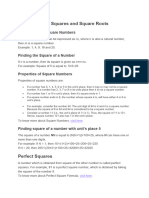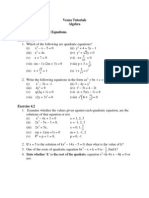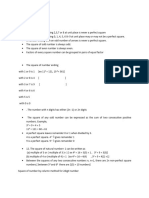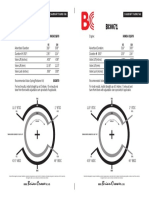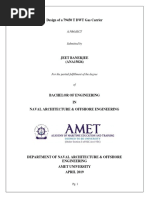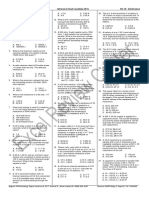Sqares
Sqares
Uploaded by
nittypiCopyright:
Available Formats
Sqares
Sqares
Uploaded by
nittypiCopyright
Available Formats
Share this document
Did you find this document useful?
Is this content inappropriate?
Copyright:
Available Formats
Sqares
Sqares
Uploaded by
nittypiCopyright:
Available Formats
1
Class: Subject: Topic:
VIII Mathematics
Squares and Square Roots
The list of Subtopics Why these? Why should I care? Common Mistakes
Squares of numbers
Square roots
Knowing where to use
squares and square roots
Properties of square
numbers
Patterns of a square of a
number
Finding the square of a
number
Finding square roots
Square roots of a decimal
Estimating square roots
Unable to differentiate
between problems that ask
for squares versus those that
ask for square roots
Placing bars over numbers
for finding square root
through long division
method
Application of squares and
square roots is used in a
wide range of topics from
mensuration and trigonom-
etry to calculus
2
1. Introduction
You know that the area of a square =
Let us observe the following table:
Side of a
square (in
cm)
Area of the square
(in cm
2
)
4 4 4 = 16 = 4
2
7 7 7 = 49 = 7
2
9 9 9 = 81 = 9
2
11 11 11 = 121 = 11
2
20 20 20 = 400 = 20
2
x x x = x
2
p p p = p
2
What is special about the numbers 4, 9, 25, 64 and other such numbers?
Since 4 can be expressed as 2 2 = 2
2
, 9 can be expressed as 3 3 = 3
2
,
all such numbers can be expressed as the product of the number with itself.
Such numbers like 1, 4, 9, 16, 25, ..... are known as square numbers of 1, 2, 3, 4, 5,......
respectively.
Squares of numbers
1. The square of a number is the product of .
Example:
The square of 5 is 5 5 = 25.
The square of
1
3
is
1
3
1
3
=
1
9
.
The square of 0.4 is (0.4) (0.4) = 0.16.
2. The square of a number is written using the square notation.
Eg: (2) (2) is written as .
7 7 is written as .
1
8
1
8
is written as .
3. 6
2
is read as 6 squared or the square of 6 or 6 to the power of 2.
4. The square notation is expanded to obtain the product of the squared number.
3
Perfect square
A natural number is said to be a perfect square, if it is the square of some other natural
number.
Example: 81 = 9
2
, 4 = 2
2
, 36 = 6
2
, 10000 = 100
2
.
Identifying a perfect square:
A given number is perfect square, if it can be expressed as the product of a pair of equal
factors.
Note: The factors can be found by prime factorisation method.
Example1: Is 225 a perfect square ?
Resolving 225 into prime factors,
5 225
45
9
3
1
5
3
3
we get, 225 =
5 5
3 3
As it is expressed as the product of equal factors hence, it is a perfect square.
Example2: Is 180 a perfect square ?
Resolving 180 into prime factors, we get, 180 =
2 2
3 3
5
Though 2 and 3 are paired, 5 is not paired.
Thus, 180 cannot be expressed as the product of pairs of equal factors.
Hence, 180 is not a perfect square.
Think: If you were told to multiply 180 by the smallest natural number to make it a
perfect square, what would that number be?
4
Some more examples:
Perfect
squares
Non-perfect
squares
9 = 3 3 = 3
2
5 = ?
25 = 5 5 = 5
2
21 = ?
Note: Though 5 can be expressed as
5 5
it is not a prefect square because
5
is not
a natural number.
Similarly, 21 is also not a perfect square.
Where to square and where to find the square root?
E.g. 1 The area of a circle is 314 cm
2
. Find its radius.
We k n ow t h at ar ea of a ci r cl e i s gi ven by t h e for mu l a,
Area = 314 cm
2
=
=
314
Thus, r =
Tick the correct answer: In the example shown here, we calculated the:
a) Square
b) Square root
c) None of the above
E.g. 2 The side of a chess board is 12 cm. Find its area.
Here, we need to calculate the square.
Area =
=
=
E.g. 3 The side of a square is 4 cm. What is the length of its diagonal?
The square of the length of the diagonal = sum of squares of the lengths of the sides.
(This is an application of the theorem).
i.e. Diagonal
2
= (Side1)
2
+ (Side2)
2
Diagonal
2
= 4
2
+ 4
2
= 16 + 16 = 32 cm
2
Thus, Diagonal =
32
cm
5
Square roots
Square roots of numbers
1. The square root of a positive number is a number which, when multiplied by itself,
equals the given positive number.
Example:
What is the square root of 25?
The square root of 25 is 5 because when 5 is multiplied by itself, the product equals
25.
5 5 = 25
The square root of 25 is 5.
2. The symbol for square root is .
Example:
The square root of 25 is denoted as
25
.
25
= 5
25
is read as the square root of twenty five.
Properties of squares of numbers
i) The square of an even number is always an even number.
Example:
6 is an even number and 6
2
= 36 which is even.
8 is an even number and 8
2
= 64 which is even.
ii) The square of an odd number is always an odd number.
Example:
7 is an odd number and 7
2
= 49 which is odd.
11 is an odd number and 11
2
= 121 which is odd.
6
Patterns of square numbers
i) Sum of first n odd natural numbers is n
2
.
Example:
1 = 1 = 1
2
[one odd number]
1 + 3 = 4 = 2
2
[sum of first two odd numbers]
1 + 3 + 5 = 9 = 3
2
[sum of first three odd numbers]
1 + 3 + 5 + 7 [ ] = 16 = 4
2
1 + 3 + 5 + 7 + 9 [ ] = 25 = 5
2
1 + 3 + 5 + 7 + 9 + 11 [ ] = 36 = 6
2
ii) Observe the squares of numbers 1, 11, 111...etc. They give a beautiful pattern:
1
2
=
11
2
=
111
2
=
1111
2
=
11111
2
=
111111
2
=
1111111
2
=
iii) Another interesting pattern:
7
2
= 49
67
2
= 4489
667
2
= 444889
6667
2
= 44448889
66667
2
= 4444488889
666667
2
= 444444888889
1
1 2 1
1 2 3 2 1
1 2 3 4 2 3 1
1 2 3 4 5 4 3 2 1
1 2 3 4 5 6 5 4 3 2 1
1 2 3 4 5 6 7 6 5 4 3 2 1
7
The numbers 4489, 444889, . . . are obtained by inserting 48 into the middle of the
preceding squares of integers 7, 67, 667, 6667, . . . respectively.
iv) The difference of squares of successive numbers is equal to their sum.
Example: 17
2
16
2
= 17 + 16
101
2
100
2
= 101 + 100
235
2
234
2
= 235 + 234
In general, (n + 1)
2
- ( n )
2
= (n + 1+ n)
= (n+1) + (n)
( )
| | | |
1 1
1
n n x
n n
( = + +
= + +
v) If 1 is added to the product of two consecutive even natural numbers, it is equal to the
square of the only odd natural number between them:
2 4 + 1 = 9 = 3
2
4 6 + 1 = 5
2
6 8 + 1 =
8 10 + 1 =
10 12 + 1 =
vi) The squares of natural numbers like 11, 111, .., etc. have a nice pattern as shown below
121 (1 + 2 + 1) = 484 = 22
2
11
2
(sum of the digits in 11
2
) = (2 11)
2
12321 (1 + 2 + 3 + 2 + 1) = 110889 = 333
2
111
2
(sum of the digits in 111
2
) = (3 111)
2
1234321 (1 + 2 + 3 + 4 + 3 + 2 + 1)
= 19749136 = (4444)
2
1111
2
(sum of the digits in 1111
2
) = (4 1111)
2
8
Square of a number sum of digits
having all ones in the square
| | | |
| |
\ . \ .
2
number of digits
= the number
in the number
| |
|
\ .
5. Pythagorean triplet
Let us observe the sum of squares of 3 and 4
i.e., 3
2
+ 4
2
= 9 + 16 = 25
3
2
+ 4
2
= 5
2
Here, the sum of squares of 3 and 4 is square of another number 5.
Since the sum of squares of two numbers is again square of another number,
these numbers (3, 4, 5) are said to form a Pythagorean triplet.
In general, a triplet (m, n and p ) of natural numbers m, n and p is said to be a Pythagorean
triplet if m
2
+ n
2
= p
2
.
Note:
i) If m > 1 and m is odd, then the Pythagorean triplet is
2 2
1 1
, ,
2 2
| | +
|
\ .
m m
m
.
Example:
If one of the numbers of a Pythagorean triplet is 3, find the triplet.
Sol.As the given number 3 is odd,
2 2
1 1
, ,
2 2
| | +
|
\ .
m m
m
i.e., m = 3
The Pythagorean triplet is
2 2
1 1
, ,
2 2
| | +
|
\ .
m m
m
2 2
3 1 3 1
i.e, 3, ,
2 2
| | +
|
\ .
8 10
i.e, 3, ,
2 2
| |
|
\ .
( ) 5 , 4 , 3 , e . i
Thus, the required triplet is (3, 4, 5).
Note:
ii) If m > 1 and 2m is one number of the triplet then the Pythagorean triplet is (2m, m
2
1, m
2
+ 1).
Example:
If one of the numbers of a Pythagorean triplet is 4, find the triplet.
Sol: As the given number 4 is even
9
i.e., 2m = 4
m = 4/2 = 2, m = 2
The Pythagorean triplet is (2m, m
2
1, m
2
+ 1)
i.e., (2(2), 2
2
1 , 2
2
+ 1)
i.e., (4,3,5)
Thus, the required triplet is (3,4,5).
Finding the Square of a Number:
Square of small numbers like 3, 4, 5, 6, 7, ...... etc. are easy to find. But can we find the
square of 23 so quickly?
The answer is not so easy and we may need to multiply 23 by 23.
There is a way to find this without having to multiply 23 23.
We know 23 = 20 + 3
Therefore 23
2
= (20 + 3)
2
= 20 (20 + 3) + 3 (20 + 3)
= 20
2
+ 20 x 3 + 3 x 20 + 3
2
= 400 + 60 + 60 + 9 = 529.
Other patterns in squares:
Consider the following pattern:
25
2
= 625 = (2 x 3) hundreds + 25
35
2
= 1225 = (3 x 4) hundreds + 25
75
2
= 5625 = (7 x 8) hundreds + 25
125
2
= 15625 = (12 x 3) hundreds + 25
Now you can find the square of 95?
10
WORKSHEET
1
1. What will be the unit digit of the squares of the following numbers?
(i) 81 (ii) 272 (iii) 799 (iv) 3853 (v) 1234 (vi) 26387 (vii) 52698
(viii) 99880 (ix) 12796 (x) 55555
2. The following numbers are obviously not perfect squares. Give reason.
(i) 1057 (ii) 23453(iii) 7928 (iv) 222222 (v) 64000 (vi) 89722 (vii) 222000
(viii) 505050
3. The squares of which of the following would be odd numbers?
(i) 431 (ii) 2826 (iii) 7779 (iv) 82004
4. Observe the following pattern and find the missing digits.
11
2
= 121
101
2
= 10201
1001
2
= 1002001
100001
2
= 121
10000001
2
=
5. Using the given pattern, find the missing numbers.
1
2
+ 2
2
+ 2
2
= 3
2
2
2
+ 3
2
+ 6
2
= 7
2
3
2
+ 4
2
+ 12
2
= 13
2
4
2
+ 5
2
+ _
2
= 21
2
5
2
+ _
2
+ 30
2
= 31
2
6
2
+ 7
2
+ _
2
= __
2
11
6. Without adding find the sum
(i) 1 + 3 + 5 + 7 + 9
(ii) 1 + 3 + 5 + 7 + 9 + 11 + 13 + 15 + 17 + 19
(iii) 1 + 3 + 5 + 7 + 9 + 11 + 13 + 15 + 17 + 19 + 21 + 23
7. (i) Express 49 as the sum of 7 odd numbers.
(ii) Express 121 as the sum of 11odd numbers.
8. How many numbers lie between squares of the following numbers?
(i) 12 and 13 (ii) 25 and 26 (iii) 99 and 100
9. Is 63504 a perfect square? If so, find the number whose square is 63504.
10. Determine whether squares of the following numbers are even or odd.
i) 213 ii) 3824 iii) 9777 iv) 40028
11. Write a Pythagorean triplet whose one member is
(i) 6 (ii) 14 (iii) 16 (iv) 18
12. Find the square of the following numbers
(i) 32 (ii) 35 (iii) 86 (iv) 93 (v) 71 (vi) 46
13. If 8 is one of the numbers in a Pythagorean triplet, then find the triplet.
12
14. Complete the following table of perfect squares and their square roots:
Perfect Square Square Root
1 1
4 2
9 3
36
8
100
13
Square roots
Let us consider 81
1/2
As 81 is raised to the power 1/2, it is said to be the square root of 81.
Denoted as
1
2
Exponential Radical
form form
81 81 =
Thus, any number a raised to the power 1/2 is said to be the square root of the given
number, denoted as
a
.
Finding Square root of a Number by Prime Factorization Method
In the previous topics we have seen different methods of finding the squares of numbers
given. Let us now have a look at the various methods for finding the square root of the
given number.
Step-1: Write the prime factorisation of the given number.
Step-2: Pair the factors such that primes in each pair are equal.
* * *
13
Step-3: Choose one prime from each pair and multiply all such primes.
Step-4: The product thus obtained is the square root of the given number.
Let us understand this method through the example given below.
Example: Find the square root of 24336.
24336 (2 2) (2 2) (3 3) (13 13) =
= 2 2 3 13 = 156
24336 156 =
WORKSHEET
2
1. What could be the possible ones digits of the square root of each of the following
numbers?
(i) 9801 (ii) 99856 (iii) 998001 (iv) 657666025
2. Without doing any calculation, find the numbers which are surely not perfect
squares.
(i) 153 (ii) 257 (iii) 408 (iv) 441
3. Find the square roots of 100 and 169 by the method of repeated subtraction.
4. Find the square roots of the following numbers by the pme factorisation method.
(i) 729 (ii) 400 (iii) 1764 (iv) 4096 (v) 7744 (vi) 9604
(vii) 5929 (viii) 9216 (ix) 529 (x) 8100
5. For each of the following numbers, find the smallest whole number by which it
should be multiplied so as to get a perfect square number. Also find the square
root of the square number so obtained.
(i) 252 (ii) 180 (iii) 1008 (iv) 2028 (v) 1458 (vi) 768
* * *
14
6. For each of the following numbers, find the smallest whole number by which it
should be divided so as to get a perfect square number. Also find the square root
of the square number so obtained.
(i) 252 (ii) 2925 (iii) 396 (iv) 2645 (v) 2800 (vi) 1620
7. The students of Class VIII of a school donated Rs 2401 in all, for Prime Ministers
National Relief Fund. Each student donated as many rupees as the number of
students in the class. Find the number of students in the class.
8. 2025 plants are to be planted in a garden in such a way that each row
contains as many plants as the number of rows. Find the number of rows and the
number of plants in each row.
9. Find the smallest square number that is divisible by each of the numbers 4, 9,
and 10.
10. Find the smallest square number that is divisible by each of the numbers 8, 15,
and 20.
11. A square has an area of 16 units
2
.
a. What is the side length of a square of this area?
b. Draw a square of area 16 units
2
below.
c. What is the square root of 16?
d. Explain why your answers in parts (a) and (c) are the same.
12. A checkerboard is a square made up of 32 black and 32 red squares.
Assume that each square has a side length of 1 unit.
a. What is the total area of the checkerboard?
b. What is the side length of the checkerboard?
c. Explain how your answers in parts (a) and (b) help you determine the
square root of 64.
13. The symbol means the positive or principal square root of a number.
a. Evaluate
121
.
b. What is the negative square root of 121?
c. A square has an area of 121 units
2
. What is the side length of square of
this area?
d. Explanin why the answer to part (c) can only be the positive square root
of 121.
15
Long Division Method:
Let us understand this method through the following example.
Example: Find the square root of 467856.
Step-1: Placing bars over every pair of digits i.e., 4678 56.
Step-2: Finding the largest number whose square is less than or equal to the left most bar.
i.e., 36 < 46 6 is the required divisor. Now divide 46 by 6.
4678 56
36
10
6
6
Step-3: Bring down the number under the next bar, beside the remainder of Step 2.
4678 56
36
10 78
6
6
Step-4: Doubling the quotient i.e., 2 6 = 12.
4678 56
36
10 78
68
6
10 24
54
128
Step-5: Guessing the largest possible digit to be taken beside the divisor and also to get the
new digit in the quotient. The required digit is8. Now divide 1078 by 128 and get the
remainder 54.
Step-6: Bringing down the number under the next bar to the right of the new remainder.
4678 56
36
1078
68
6
1024
54 56
128
16
Step-7: Repeating the steps 4, 5 and 6 till all the bars have been considered. The final
quotient is the required square root.
4678 56
36
1078
684
6
1024
54 56
128
1364
54 56
0
467856 684 =
Note: This method is more efficient with larger numbers, but it can also be used to find
square root of smaller numbers i.e., 3 digit or 4 digit numbers.
Estimating Square Roots
Most calculators have a square root button that quickly calculates square roots. There are
other ways of calculating square roots but they arent quick. If you need an approximate
value for a square root you can use a method like the one below.
What is the square root of 42?
What two squares does 42 come between? 36 and 49
What are the square roots of 36 and 49 6 and 7
So the square root of 42 is between 6 and 7.Lets use some trial and error to get an
approximate answer.
Lets try 6.5 42 6.5 = 6.46
Were looking to get the number we divide by to be as close to the answer we get as
possible. In this case we have 6.5 and 6.46Close, but we can get closer.
Lets take the average of 6.5 and 6.46 and try that. 42 6.48 = 6.48
So we have an square root that is accurate to two decimal places. You can repeat
these steps to get as accurate an answer as you want.
17
Finding Square Root by Assumption Method
Steps for finding the square roots up to four digit numbers, without using either
factorization or division methods.
Step-1: Find the largest number whose square is less than (or) equal to the number
under the left most bar. This is the tens digit of the square root.
Step-2: Find the units digit by squaring the relative number.
Step-3: Choose the correct digit by squaring one possible square root and comparing it
with the given number.
Example: Find the square root of 9801.
Sol: 98 01
Step-1: 9
2
= 81 is the largest square number < 98;
The tens digit in the square root of 9801 is 9.
9801 =9 ? ;
Step-2: 1
2
= 1 ; 9
2
= 8 1 in both the cases, the units digit is 1.
Step-3: Trial 91
2
= 8281
=
9801
i.e., 1 doesnt satisfy the units digit of square root of 9801.
9801 99 =
Example: Find the square roots of 144 and 6561.
Sol: 144
Step-1: 1 44
1
2
= 1
Tens digit in square root of 144 is 1. 144 1 ? =
Step-2: 2
2
= 4 ; 8
2
= 6 4
In both the cases, the units digit is 4.
Step-3: Trial 12
2
= 144 144 12 =
Example: Find the square roots of 6561.
18
Sol: 6561
Step-1: 65 61
8
2
= 64
Tens digit in square root of 6561 is 8 . 6561 8 = ?
Step-2: 1
2
= 1 ; 9
2
= 8 1
In both the cases, the units digit is 1.
Step-3: Trial 80
2
= 6400 is closer to 6561 than 90
2
= 8100
6561
is closer to 80 than 90
The tens digit of square root may be 8
Square root of 6561 may be 81
Verification : 8181=6561
6561 81 =
Square roots of decimals
Step-1: Place bars on the integral part of the number in the usual manner.
Step-2: Place bars on the decimal part on every pair of digits beginning with the first
decimal place.
Step-3: Start finding the square root by the division process as usual.
Step-4: Place decimal point in the quotient as soon as the integral part is over.
Step-5: Stop when the remainder is zero.
Step-6: The quotient at this stage is the square root.
Example: Find the square root of 0.00059049
Step-1: Here, integral part is 0. So place a bar on 0.
Step-2: Starting from the first decimal point, place the bars on every pair of digits. i.e.,
00059049
.
19
Step-3: Start finding the square root and place the decimal point in the quotient as
soon as the integral part is over.
0.00059049
4
1 90
0.0243
2
44
0
1 76
1449
1449
483
0.0005905 0.0243 =
Tip (i) : If the integral part is zero in the given decimal number, then the integral part in
the square root is also zero.
Tip (ii): If the first pair after the decimal point is 00, then the first digit after the decimal
in the square root is also zero.
20
WORKSHEET
3
1. A man arranges 15376 apple plants in his garden in an order, so that there are as
many rows as there are apple plants in each row. Find the number of rows.
2. The product of three consecutive even numbers when divided by 8 is 720. Find
the product of their square roots.
3. What least number must be subtracted from 16160 to get a perfect square? Also
find the square root of this perfect square.
4. What least number must be added to 2945 to get a perfect square number? What
is the resulting number? Find the square root of the resulting number.
5. Find the greatest number of 5 digit which is a perfect square.
6. Find the least number of six digits which is a perfect square.
7. Find the value of
0.9
up to 3 places of decimal.
8. Find the value of
3
correct to 3 places of decimal.
9. Find the value of
3
7
up to four decimal places
10. Find the square root of each of the following numbers by division method.
(i) 2304 (ii) 4489 (iii) 3481 (iv) 529 (v) 3249 (vi) 1369
(vii) 5776 (viii) 7921 (ix) 576 (x) 1024 (xi) 3136 (xii) 900
21
11. Find each square root:
1. -
441
2.
0
3.
324
4.
25
81
5.
256
16
6. -
4
484
7.
3.61
8. -
0.64
9. -
0.01
10.
274576
11.
58081
12.
152.2756
12. Estimate the square roots of the following to the closest tenth:
1.
28.28
2.
500
3.
350
4.
31.89
5.
40.04
6.
110
22
Lower Perfect
Square
Square Root
Area = 75 units
2
Upper Perfect
Square
Square Root
b. Using the table completed in part (a), answer the following question:
Which perfect square is closer to 75: the lower perfect square or the upper
perfect square? Tick your answer below:
Lower Perfect Square or Upper Perfect Square
c. Estimate the square root of 75:
75
=
(nearest tenth)
d. Can you use the same lower and upper squares to estimate the value of
89?
Explain why or why not?
13. The square roots of some numbers are not whole numbers. Suppose you
construct a square of area 75 units
2
.
a. Fill in the blanks below:
23
14. Fill in the blanks below to estimate the square roots of non-perfect squares:
a. Area = 108 units
2
Lower Perfect
Square
Square Root
Area = 108 units
2
Upper Perfect
Square
Square Root
108 =
(nearest tenth)
b. Area = 12 units
2
Lower Perfect
Square
Square Root
Area = 12 units
2
Upper Perfect
Square
Square Root
12 =
(nearest tenth)
24
c. Area = 126.8 units
2
Lower Perfect
Square
Square Root
Area = 126.8 units
2
Upper Perfect
Square
Square Root
126.8 =
(nearest tenth)
d. Area = 46.2 units
2
Lower Perfect
Square
Square Root
Area = 46.2 units
2
Upper Perfect
Square
Square Root
46.2 =
(nearest tenth)
25
15. Which letter on the number line below corresponds to each square root?
56 __________
10 __________
39 __________
7 __________
32 __________
98 __________
You might also like
- Final Attachment Report For Electrical & Electronics Engineering84% (43)Final Attachment Report For Electrical & Electronics Engineering29 pages
- Introduction To Squares and Square Roots NOTESNo ratings yetIntroduction To Squares and Square Roots NOTES4 pages
- Class 8 Mathematics NCERT Solutions Chapter 5 Squares and Square RootsNo ratings yetClass 8 Mathematics NCERT Solutions Chapter 5 Squares and Square Roots61 pages
- Class 8 Chapter 6 Square and Square RootsNo ratings yetClass 8 Chapter 6 Square and Square Roots6 pages
- P6 Mathematics Lesson Notes Self Study Lesson Set One Cornerstone Junior School MukonoNo ratings yetP6 Mathematics Lesson Notes Self Study Lesson Set One Cornerstone Junior School Mukono7 pages
- Chapter - Vi Squares and Square Roots (Math) : Exercise 6.1No ratings yetChapter - Vi Squares and Square Roots (Math) : Exercise 6.136 pages
- Minimum Learning Material-Maths-target 40class XNo ratings yetMinimum Learning Material-Maths-target 40class X16 pages
- VIII Textbook Solu - Squares and Square RootsNo ratings yetVIII Textbook Solu - Squares and Square Roots36 pages
- Grade 8 Notes (Square and Square Root) 1 - 1686649427No ratings yetGrade 8 Notes (Square and Square Root) 1 - 16866494276 pages
- NUMBERS - PPT Gen Aptitude - 1st Yr SRMNo ratings yetNUMBERS - PPT Gen Aptitude - 1st Yr SRM17 pages
- FALL WIN SEM (2023-24) STS1004 TH AP2023243000841 Reference Material II 07-Oct-2023 L12-Six Phrase-Squares and Square RootsNo ratings yetFALL WIN SEM (2023-24) STS1004 TH AP2023243000841 Reference Material II 07-Oct-2023 L12-Six Phrase-Squares and Square Roots27 pages
- M8 Square&SquareRoots WS 1686572342916 2aKjPNo ratings yetM8 Square&SquareRoots WS 1686572342916 2aKjP3 pages
- CBSE NCERT Solutions For Class 8 Mathematics Chapter 6: Back of Chapter QuestionsNo ratings yetCBSE NCERT Solutions For Class 8 Mathematics Chapter 6: Back of Chapter Questions32 pages
- Master Fundamental Concepts of Math Olympiad: Maths, #1From EverandMaster Fundamental Concepts of Math Olympiad: Maths, #1No ratings yet
- GCSE Mathematics Numerical Crosswords Foundation Written for the GCSE 9-1 CourseFrom EverandGCSE Mathematics Numerical Crosswords Foundation Written for the GCSE 9-1 CourseNo ratings yet
- Factoring and Algebra - A Selection of Classic Mathematical Articles Containing Examples and Exercises on the Subject of Algebra (Mathematics Series)From EverandFactoring and Algebra - A Selection of Classic Mathematical Articles Containing Examples and Exercises on the Subject of Algebra (Mathematics Series)No ratings yet
- GCSE Mathematics Numerical Crosswords Higher Tier Written for the GCSE 9-1 CourseFrom EverandGCSE Mathematics Numerical Crosswords Higher Tier Written for the GCSE 9-1 CourseNo ratings yet
- Mindful Maths 1: Use Your Algebra to Solve These Puzzling PicturesFrom EverandMindful Maths 1: Use Your Algebra to Solve These Puzzling PicturesNo ratings yet
- Chapter 7 - Electricity (Teacher's Guide)No ratings yetChapter 7 - Electricity (Teacher's Guide)61 pages
- 2.CALENBERG Vibration Insulation Bearings Civalit Sliding Bearing enNo ratings yet2.CALENBERG Vibration Insulation Bearings Civalit Sliding Bearing en4 pages
- Numerical Study on the Automatic Ballast Control of a Floating DockNo ratings yetNumerical Study on the Automatic Ballast Control of a Floating Dock12 pages
- Intel Microprocessor Quick Reference Guide - Product FamilyNo ratings yetIntel Microprocessor Quick Reference Guide - Product Family54 pages
- Electrical Dimensioning of Inverter-Inductor-Load System in Induction Heating of Ferromagnetic Plates As LoadNo ratings yetElectrical Dimensioning of Inverter-Inductor-Load System in Induction Heating of Ferromagnetic Plates As Load10 pages
- Cement and Concrete Research: M.S. Abo Dhaheer, S. Kulasegaram, B.L. KarihalooNo ratings yetCement and Concrete Research: M.S. Abo Dhaheer, S. Kulasegaram, B.L. Karihaloo8 pages
- Physics Paper 1: Provided by Dse - LifeNo ratings yetPhysics Paper 1: Provided by Dse - Life16 pages
- Evaluation of Digital Photography From Model Aircraft For Remote Sensing of Crop Biomass and Nitrogen StatusNo ratings yetEvaluation of Digital Photography From Model Aircraft For Remote Sensing of Crop Biomass and Nitrogen Status21 pages
- Introduction To WPF: Contoso Healthcare Sample ApplicationNo ratings yetIntroduction To WPF: Contoso Healthcare Sample Application37 pages
- Oracle Database 21c Enterprise Edition Release 21No ratings yetOracle Database 21c Enterprise Edition Release 2125 pages
- Be - Computer Engineering - Semester 3 - 2023 - December - Computer Graphicsrev 2019 C SchemeNo ratings yetBe - Computer Engineering - Semester 3 - 2023 - December - Computer Graphicsrev 2019 C Scheme1 page
- Final Attachment Report For Electrical & Electronics EngineeringFinal Attachment Report For Electrical & Electronics Engineering
- Geometry Snacks: Bite Size Problems and How to Solve ThemFrom EverandGeometry Snacks: Bite Size Problems and How to Solve Them
- Class 8 Mathematics NCERT Solutions Chapter 5 Squares and Square RootsClass 8 Mathematics NCERT Solutions Chapter 5 Squares and Square Roots
- P6 Mathematics Lesson Notes Self Study Lesson Set One Cornerstone Junior School MukonoP6 Mathematics Lesson Notes Self Study Lesson Set One Cornerstone Junior School Mukono
- Chapter - Vi Squares and Square Roots (Math) : Exercise 6.1Chapter - Vi Squares and Square Roots (Math) : Exercise 6.1
- Grade 8 Notes (Square and Square Root) 1 - 1686649427Grade 8 Notes (Square and Square Root) 1 - 1686649427
- FALL WIN SEM (2023-24) STS1004 TH AP2023243000841 Reference Material II 07-Oct-2023 L12-Six Phrase-Squares and Square RootsFALL WIN SEM (2023-24) STS1004 TH AP2023243000841 Reference Material II 07-Oct-2023 L12-Six Phrase-Squares and Square Roots
- CBSE NCERT Solutions For Class 8 Mathematics Chapter 6: Back of Chapter QuestionsCBSE NCERT Solutions For Class 8 Mathematics Chapter 6: Back of Chapter Questions
- Basic Mathematics. Explained Easy | For BeginnersFrom EverandBasic Mathematics. Explained Easy | For Beginners
- Master Fundamental Concepts of Math Olympiad: Maths, #1From EverandMaster Fundamental Concepts of Math Olympiad: Maths, #1
- GCSE Mathematics Numerical Crosswords Foundation Written for the GCSE 9-1 CourseFrom EverandGCSE Mathematics Numerical Crosswords Foundation Written for the GCSE 9-1 Course
- Factoring and Algebra - A Selection of Classic Mathematical Articles Containing Examples and Exercises on the Subject of Algebra (Mathematics Series)From EverandFactoring and Algebra - A Selection of Classic Mathematical Articles Containing Examples and Exercises on the Subject of Algebra (Mathematics Series)
- GCSE Mathematics Numerical Crosswords Higher Tier Written for the GCSE 9-1 CourseFrom EverandGCSE Mathematics Numerical Crosswords Higher Tier Written for the GCSE 9-1 Course
- Elementary Algebra Notes Examples and ExercisesFrom EverandElementary Algebra Notes Examples and Exercises
- Mindful Maths 1: Use Your Algebra to Solve These Puzzling PicturesFrom EverandMindful Maths 1: Use Your Algebra to Solve These Puzzling Pictures
- Origami Dots: Folding paper to explore geometryFrom EverandOrigami Dots: Folding paper to explore geometry
- 2.CALENBERG Vibration Insulation Bearings Civalit Sliding Bearing en2.CALENBERG Vibration Insulation Bearings Civalit Sliding Bearing en
- Numerical Study on the Automatic Ballast Control of a Floating DockNumerical Study on the Automatic Ballast Control of a Floating Dock
- Intel Microprocessor Quick Reference Guide - Product FamilyIntel Microprocessor Quick Reference Guide - Product Family
- Electrical Dimensioning of Inverter-Inductor-Load System in Induction Heating of Ferromagnetic Plates As LoadElectrical Dimensioning of Inverter-Inductor-Load System in Induction Heating of Ferromagnetic Plates As Load
- Cement and Concrete Research: M.S. Abo Dhaheer, S. Kulasegaram, B.L. KarihalooCement and Concrete Research: M.S. Abo Dhaheer, S. Kulasegaram, B.L. Karihaloo
- Evaluation of Digital Photography From Model Aircraft For Remote Sensing of Crop Biomass and Nitrogen StatusEvaluation of Digital Photography From Model Aircraft For Remote Sensing of Crop Biomass and Nitrogen Status
- Introduction To WPF: Contoso Healthcare Sample ApplicationIntroduction To WPF: Contoso Healthcare Sample Application
- Be - Computer Engineering - Semester 3 - 2023 - December - Computer Graphicsrev 2019 C SchemeBe - Computer Engineering - Semester 3 - 2023 - December - Computer Graphicsrev 2019 C Scheme






